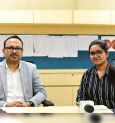What is a bone marrow transplant? How can a bone marrow transplant in cancer treatment bring back a healthy life? How are bone marrow donors selected? Hematologist, Oncologist and bone marrow transplant physician Dr. Shishir Patra elaborates on bone marrow transplantation.
Firstly, what is bone marrow transplantation? Dr. Sishir Patra explained to us that bone marrow transplantation, also known as stem cell transplantation, is a highly effective treatment for various diseases, including cancer. It offers hope and the possibility of a healthier life for patients facing these challenging conditions. The procedure's success depends on careful donor selection and advanced medical techniques, making it a beacon of hope for those in need. In this process, the donors are carefully selected individuals whose stem cells are to be used in the therapy.
Stem cell transplantation is primarily used in various types of cancer, including acute leukaemia, acute hypoplastic leukaemia, acute minor leukaemia, Hodgkin lymphoma, non-Hodgkin lymphoma, and multiple myeloma.
Unlike traditional surgical procedures, bone marrow transplantation is a non-surgical process. It involves the collection of stem cells, usually from a donor's bone marrow. This is done through a special procedure called apheresis, which safely extracts stem cells from the donor's bloodstream. The patient is then prepared for transplantation with conditioning medicines, which help create the ideal environment for the new stem cells.
Before performing a bone marrow transplant, patients typically undergo chemotherapy treatment. If the patient responds well to chemotherapy, a transplant may not be necessary. However, if chemotherapy is ineffective or if the cancer relapses, stem cell transplantation becomes a vital option.
Certain diseases require a unique approach to transplantation. For instance, in multiple myeloma cases, an autologous transplant is performed, where the patient's own stem cells are harvested, stored, and then reinfused after high-dose chemotherapy.
When an allogeneic transplant is needed, a suitable donor is sought. This donor can be a family member, such as a sibling, if they are a full match. If a match isn't found within the family, registries both in India and abroad offer a chance to find unrelated donors. These donors are part of an HLA (human leukocyte antigen) registry. Matching the patient with a suitable donor is crucial for the success of the transplantation.
Bone marrow transplantation is not limited to cancer treatment; it is also used for various other conditions, such as thalassemia. Thalassemia patients with matching related donors or from unrelated registries can greatly benefit from this procedure, with an 80% chance of a complete cure and no further need for blood transfusions.
Another condition where bone marrow transplantation has shown promise is aplastic anaemia, a non-cancerous disorder that affects blood cell production. When performed on patients aged 40–50 or younger, the outcomes are very favourable, with an 80% chance of full recovery.
The bone marrow donation process is safe for the donor, and stem cell collection is a closed system with no risk of infection or complications.
 বাংলায় পড়ুন
বাংলায় পড়ুন













